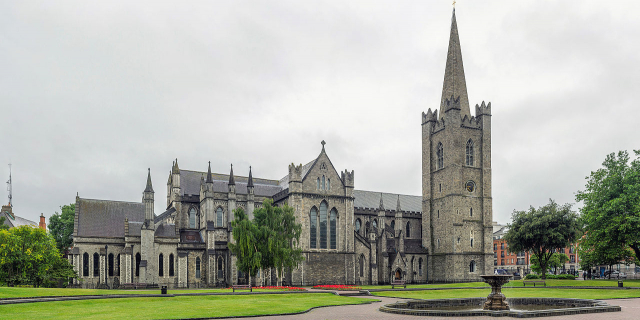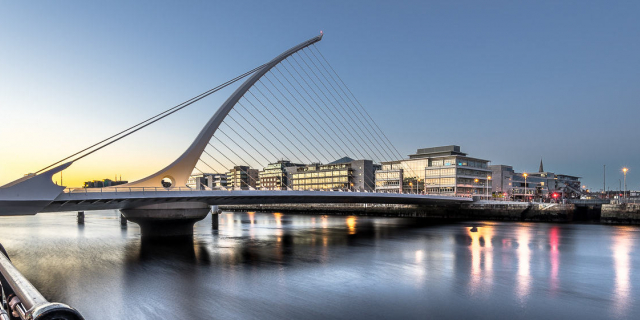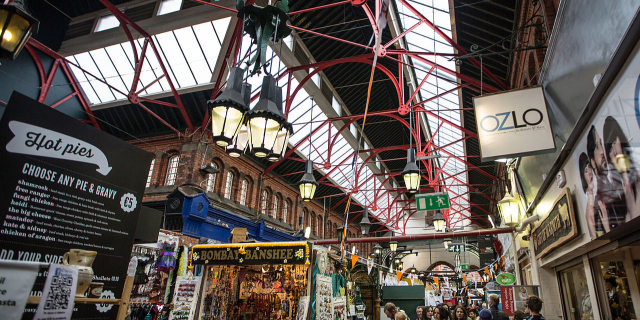Dublin Castle (Irish: Caisleán Bhaile Átha Cliath) is a former motte-and-bailey castle and current Irish government complex and conference centre. It was chosen for its position at the highest point of central Dublin.
Until 1922 it was the seat of the British government's administration in Ireland. Much of the current buildings date from the 18th century, though a castle has stood on the site since the days of King John, the first Lord of Ireland. The Castle served as the seat of English, then later British, government of Ireland under the Lordship of Ireland (1171–1541), the Kingdom of Ireland (1541–1800), and the United Kingdom of Great Britain and Ireland (1800–1922).
After the signing of the Anglo-Irish Treaty in December 1921, the complex was ceremonially handed over to the newly formed Provisional Government led by Michael Collins. It now hosts the inauguration of each President of Ireland and various State r...Read more
Dublin Castle (Irish: Caisleán Bhaile Átha Cliath) is a former motte-and-bailey castle and current Irish government complex and conference centre. It was chosen for its position at the highest point of central Dublin.
Until 1922 it was the seat of the British government's administration in Ireland. Much of the current buildings date from the 18th century, though a castle has stood on the site since the days of King John, the first Lord of Ireland. The Castle served as the seat of English, then later British, government of Ireland under the Lordship of Ireland (1171–1541), the Kingdom of Ireland (1541–1800), and the United Kingdom of Great Britain and Ireland (1800–1922).
After the signing of the Anglo-Irish Treaty in December 1921, the complex was ceremonially handed over to the newly formed Provisional Government led by Michael Collins. It now hosts the inauguration of each President of Ireland and various State receptions.
The castle was built by the dark pool ("Dubh Linn") which gave Dublin its name. This pool lies on the lower course of the River Poddle before its confluence with the River Liffey; when the castle was built, the Liffey was much wider, and the castle was effectively defended by both rivers. The Poddle today runs under the complex.
 Soldiers at Dublin Castle in 1830
Soldiers at Dublin Castle in 1830 Dublin Castle and Black Pool
Dublin Castle and Black Pool The Record Tower, the sole surviving tower of the medieval castle dating from c. 1228. To its left is the Chapel Royal.
The Record Tower, the sole surviving tower of the medieval castle dating from c. 1228. To its left is the Chapel Royal.Dublin Castle was first founded as a major defensive work by Meiler Fitzhenry on the orders of King John of England in 1204,[1] sometime after the Norman invasion of Ireland in 1169, when it was commanded that a castle be built with strong walls and good ditches for the defence of the city, the administration of justice, and the protection of the King's treasure.[2] Largely complete by 1230, the castle was of typical Norman courtyard design, with a central square without a keep, bounded on all sides by tall defensive walls and protected at each corner by a circular tower. Sited to the southeast of Norman Dublin, the castle formed one corner of the outer perimeter of the city, using the River Poddle as a natural means of defence along two of its sides. The city wall directly abutted the castle's northeast Powder Tower, extending north and westwards around the city before rejoining the castle at its southwestern Bermingham Tower. In 1620 the English-born judge Luke Gernon was greatly impressed by the wall: "a huge and mighty wall, foursquare, and of incredible thickness".[3] In the 17th century, the Earl of Arran described the Castle as "the worst castle in the worst situation in Christendom".[4]
The Poddle was diverted into the city through archways where the walls adjoined the castle, artificially flooding the moat of the fortress's city elevations. One of these archways and part of the wall survive buried underneath the 18th-century buildings, and are open for public viewing.[5]
 Soldiers at Dublin Castle, c. 1905
Soldiers at Dublin Castle, c. 1905Through the Middle Ages the wooden buildings within the castle square evolved and changed, the most significant addition being the Great Hall built of stone and timber, variously used as Parliament house, court of law and banqueting hall. The building survived until 1673, when it was damaged by fire and demolished shortly afterwards. The Court of Castle Chamber, the Irish counterpart to the English Star Chamber, sat in Dublin Castle in a room which was specially built for it about 1570. The Castle sustained severe fire damage in 1684. Extensive rebuilding transformed it from a medieval fortress to a Georgian palace. No trace of medieval buildings remains above ground level today, with the exception of the great Record Tower (c. 1228–1230); it is the sole surviving tower of the original fortification, its battlements an early 19th-century addition.[6]
In 1764, an English traveller named John Bush visited Dublin and had the following to say about the castle: "The Castle, as it is called from its having been the situation of one, I suppose, of which at present there are very few remains, is the residence of the lord lieutenant when in Ireland, but has very little of grandeur in its external appearance besides the large square court-yard, which it encloses. But the rooms, some of them, are large and elegant".[7]
United Irishmen General Joseph Holt, a participant in the 1798 Rising, was incarcerated in the Bermingham Tower before being transported to New South Wales in 1799.
In 1884 officers at the Castle were at the centre of a sensational homosexual scandal incited by the Irish Nationalist politician William O'Brien through his newspaper United Ireland.[8]
In 1907 the Irish Crown Jewels were stolen from the Castle. Suspicion fell upon the Officer of Arms, Sir Arthur Vicars, but rumours of his homosexuality and links to socially important gay men in London, may have compromised the investigation. The jewels have never been recovered.[9]
 Plan of Dublin Castle and grounds with pedestrian entrance highlighted
Plan of Dublin Castle and grounds with pedestrian entrance highlighted Carved head of Saint Patrick on the Chapel Royal
Carved head of Saint Patrick on the Chapel Royal Panorama
PanoramaAt the very beginning of the Easter Rising of 1916, a force of twenty-five Irish Citizen Army members were able to seize the entrance and guard room of the Castle before reinforcements for the small garrison arrived.[10] During the Anglo-Irish War the Castle was the nerve centre of the British effort against Irish separatism. On the night of Bloody Sunday in 1920, three Irish Republican Army members Dick McKee, Conor Clune and Peadar Clancy, were tortured and killed there.[11][12][13]
When the Irish Free State came into being in 1922, Dublin Castle ceased to function as the administrative seat. It served for some years as temporary Courts of Justice (the Four Courts, the home of the Irish courts' system, had been destroyed in 1922). After the courts vacated the premises, the Castle was used for state ceremonies. As President of the Executive Council, Éamon de Valera received credentials there from newly arrived ambassadors to Ireland on behalf of King George V in the 1930s. In 1938, Douglas Hyde was inaugurated as President of Ireland at the Castle. All inaugurations of subsequent presidents have taken place there since. President Erskine Hamilton Childers' lying-in-state took place there in November 1974, as did that of former President Éamon de Valera in September 1975.



































Add new comment